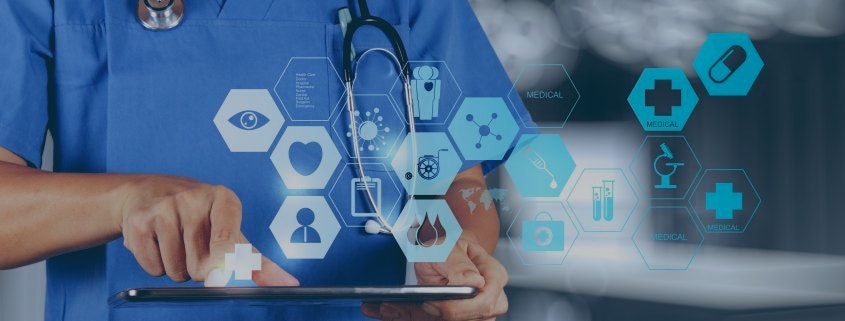‘An app a day keeps the doctor away’
Author
Victor Visser
Published
05 October 2018
Reading time
6:00 minutes
Within healthcare, the combination of new technologies such as Big Data, Artificial Intelligence (AI), Virtual/Augmented Reality (VR/AR) and Internet-of-Things (IoT) offers unprecedented opportunities. But how can you really have a positive impact on the lives of patients and healthcare professionals with these technologies?
How to use eHealth for more personal, more effective care?
A question, raised at NRC Live, aroused my curiosity and eventually brought me to their Zorgtech event on September 13th. in Amsterdam. During the symposium experts from various sectors (healthcare, government, patient associations, business, etc.) explored eHealth developments.
The success of effective and valuable eHealth solutions is based on six conditions, which I will explain through my review of the most relevant presentations.
1. Put the patient center stage
Wouldn't it be nice if patients no longer had to go to the hospital for every check-up? And if doctors only treat when necessary? Only by forming a good picture of what the dreams and needs of patients are can you arrive at relevant care solutions. Personalization plays an important role in this.
In his presentation a 'Digital therapeutics', Chris Hogg (Propeller Health) describes a solution of smart asthma inhalers linked to an app. The essence is that data from medical treatment is collected and analyzed via apps and sensors. The app provides personalized advice to both the patient and doctor about the best treatment steps. Many patient data can be analyzed via machine learning (part of AI). In this way, a doctor can make a better risk assessment of who needs to go to the hospital for a check-up, and who can manage with 'self-management' with the app. This ensures a more efficient, and more reliable care system, as well as less burden on the patient.
A major challenge of digital therapeutics is the danger of generating an overload of apps focused on a single condition. Its holy grail is a multi-disease system and combined treatments. The ultimate goal is to provide the right intervention to the right patient at the right time.
I see this as a textbook example of a successful innovation where Design, Technology and Care go well together and where the care solution revolves around the patient.
2. Co-create
No one can take care of innovation in healthcare on his own. It requires a coordinated, multidisciplinary approach, in which you also involve the target group. Shared understanding, speaking the same language and a common vision are of great importance.
Co-creation is key in the fascinating story of Wouter van Solinge (ambassador eHealth & Big Data, UMC Utrecht). He speaks of a steady evolution of data analytics in healthcare. However, although a lot is being invested, there is little evidence that hospitals actually apply data analytics in practice. Meanwhile, the tech giants are ready with their masterplans for data-driven care, where personalized, patient-friendly services will be the standard.
In response to these master plans, the UMCU has started ADAM ('Applied Data Analytics in Medicine'). The aim of this initiative is a digitally supported hospital with personalized data-driven care. Multidisciplinary teams work on innovative solutions for various areas in healthcare through short-cycle pilots. Co-creation forms the basis for success here. And help from outside is not shunned.
A good example was that blood poisoning with vulnerable premature babies can be detected 24 hours earlier than usual. Medical intervention can be done much faster so that the chances of survival are considerably increased.
Such pilots set an inflexible and compartmentalized organization in motion. According to Wouter, it should be “above all a clinical (medical) party with intensive IT involvement.”
In this view, I miss the notion that good care innovation should above all be a 'party' for the patient and/or his family.
3. Be curious, experiment, learn and enthuse
“Curiosity saves the cat.” Without an open and outward look, traditional care will eventually be overtaken by the many startups and the tech giants. A culture and mindset where there is room for continuous exploration and experimentation is vital for the healthcare sector and, ultimately, for the patient as well.
Johan Vesseur (project leader eHealth Vilans, knowledge center for long-term care) has understood this well. He outlines how his organization, using techniques like Design Thinking, tries to answer the question how important technological themes of the future can be made manageable for healthcare workers.
Following the motto of Pipi Longstocking (“I've never done it, so I think I can do it.”), Vilans regularly organizes experiments involving healthcare professionals and clients, to find out what technology can do for them. For example, they look at how Augmented Reality can support the care worker. In doing so, they make smart use of future scenarios in which they visualize in an inspiring way what the healthcare world could look like in a few years' time. The results of these experiments are valuable for innovations with added value for patients and nurses.
As a designer I was pleased to see that there are parties in the more conservative care sector that experiment with inevitable technological developments from a human and open vision.
4. Look at the big picture
An eHealth solution is always part of a broader context. During his care journey, a patient comes into contact with several people, applications, systems and environments. It is important that this broader context is taken into account, so that it optimally connects with the solution.
With their award-winning IoT solution, the company AntTail goes further than just the delivery of medications. Mark Roemers (co-founder AntTail) explains how they improve the storage temperature of rheumatism medicines and the adherence to treatment of their use. They offer a smart ecosystem of packaging, sensors, cloud data collection, smartphone apps, and customer portals. Pilots have shown that at least 85% (instead of a former 8%) of patients store their rheumatoid arthritis medicines at the correct temperature thanks to this solution. This equates to a potential cost saving of 100 million euros per year and an improvement in quality of life. However, further development is hampered by the divergent interests of hospitals, legislators, pharmaceutical companies and health insurers.
To me, it shows the need to identify these interests in an early stage, and to integrate them into your innovation approach. That does not mean that your innovation must necessarily be guided by today's limitations. Sometimes a good solution is needed to get parties moving.
5. Use technology… yet responsibly
Technology and data must be put at the service of the patient and care provider, for example through 'privacy by design'. An ethically responsible approach and control of your own data is of great importance.
Maxine Mackintosh (co-founder of One Healthtech) explains that the fear and lack of trust for data sharing is a major problem in the medical world. Although this world itself seems relatively reliable, we still find data sharing difficult in this context. In contrast, we unwittingly share our entire lives with companies that have a dubious reputation for privacy, such as Facebook and Google. But apparently there is sufficient 'personal advantage' in return.
According to Maxine, we should therefore tell a different, more human story about data sharing. What’s in it for the patients? How does it add to their quality of life? How can we help others by sharing our medical data? She makes an interesting comparison between organ and data donation, because with both forms of donation you can save someone else's life.
But how to deal with human fears? The company Deepmind has drawn up twelve principles (.pdf) through independent healthcare experts, in which the data provider, privacy, transparency, security, anti-monopoly and ethics always play a central role. I believe such principles are essential for data-driven healthcare solutions, although I find it quite uncomfortable to know that Alphabet (formerly Google) is be the parent company of Deepmind.
6. Look closely at startups and tech giants
Several presentations point to the rise of startups and the tech giants in healthcare. What these parties do very well is that they strive for the ultimate customer experience. Their organization and internal processes are designed for such an experience, as is the smart use of data technology.
If you want to remain relevant as a healthcare provider in the future, you must choose an approach that puts your own organization and processes fully at the service of patient needs.
Service design as an ‘enabler’
It is difficult to meet all the conditions mentioned during the development of care concepts. Not without reason, the associated methodology is considered a specialism: service design. Service designers have the ideal perspective and the tools to fill in the above conditions in an innovation process. Their role in this is mainly investigative, creating and coordinating.
Like no other professional, service designers can bring all interests together, enthuse people, formulate a common goal and together create the most valuable and patient-friendly care solutions.
Would you like to know more about service design (in healthcare)? Please feel free to contact me.
About the author

Customer experience
Service Design
Events
Zorgdomein
Events



